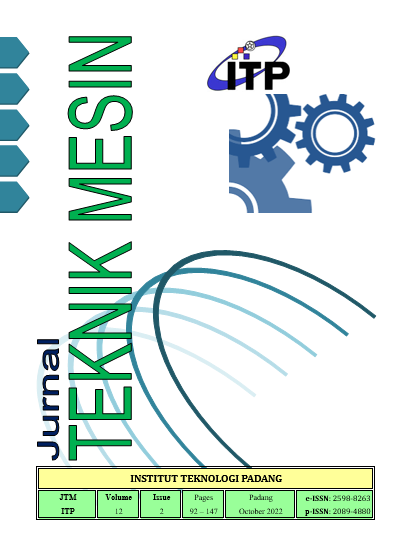Design and Manufacturing of Wind Tunnel for Turbine Impeller Airfoil Testing
DOI:
https://doi.org/10.21063/jtm.2022.v12.i2.124-130Kata Kunci:
open closed wind tunnel, test section, diffuserAbstrak
In this study, the design of a wind tunnel was carried out to observe airflow through an airfoil, streamlines and turbine blades. To accommodate this, in this study a design was made of an open return wind tunnel. In this case, an open circuit wind tunnel type will be made because the construction is simpler and the manufacturing costs are relatively cheaper compared to the closed circuit wind tunnel type. The Wind Tunnel is designed with Open CLosed Wind Tunnel (OCWT) type. The OCWT is designed to consist of fan and housing, diffuser, test section, contraction, honeycomb. The OCWT design uses an operating fan to circulate air into the test section. The maximum air speed in the Test Section is 5 m/s with a flow that is closed to laminar. The recommended diffuser has a dimension of 50 cm on the side that is attached to the test section and 52 cm on the side facing the fan with an inclination angle of 1.79o. The driver uses a 16 inch exhaust fan with a power of 74 W to make the flow in the Test Section stable at a speed of 2 m/s.
Referensi
M. Uliczka and I. Smykl, “Determining aircraft aerodynamic characteristics of regular and non-linear airframes and evaluating the efficiency of the applied methods,” Journal of Physics: Conference Series, 1736 (2021) 012048, DOI:10.1088/1742-6596/1736/1/012048.
K. Ro, J.W. Kamman and J. Barlow, “Flight Mechanics of a Free-wing Tilt-body Aircraft,” Aeronautical Journal-New Series, Vol. 112, No. 1137, DOI:10.1017/S0001924000002608.
Y. Tominaga and M. Shirzadi, “Wind tunnel measurement of three-dimensional turbulent flow structures around a building group: Impact of high-rise buildings on pedestrian wind environment,” Building and Environment, Volume 206, December 2021, 108389.
Z. Namirian, S. Mathure, B. Thorat and S. Khetree, “Modeling and Wind Flow Analysis of an Eiffel (Open) Type Sub-Sonic Wind Tunnel,” Global Journal of Researches in Engineering: A Mechanical and Mechanics Engineering. Volume 21 Issue 1 Version 1.0 Year 2021. Type: Double Blind Peer Reviewed International Research Journal. Publisher: Global Journals. Online ISSN: 2249-4596 & Print ISSN: 0975-5861.
M.A.G. Hernández, A.I.M. López, A.A. Jarzabek, J. M.P. Perales, Y. Wu and S. Xiaoxiao, “Design Methodology for a Quick and Low-Cost Wind Tunnel,” DOI: 10.5772/54169.
A. Budiprasojo and M.R. Firmansyah,” Aerodynamic Analysis In The Design Of An Electric Vehicle Model Tobacco Style M-164 With Computational Fluid Dynamic (CFD) Method,” Jurnal Rekayasa Mesin, Vol. 13 No. 2 (2022), DOI: 10.21776/jrm.v13i2.1051.
O.D. Almeida, & F.C.D. Miranda, O.F. Neto and F.G. Saad, (2018), “Low Subsonic Wind Tunnel – Design and Construction,” Journal of Aerospace Technology and Management. 10. 10.5028/jatm.v10.716. DOI:10.5028/jatm.v10.716.
Assato, Marcelo & Girardi, Roberto & Fico Jr, Nide & Mello, Olympio & Komatsu, Paulo. (2004). Research Wind Tunnel of the Aeronautical Institute of Technology: Conceptual Design and Calibration. 10.2514/6.2004-724.
Benne, Michael & Dowgwillo, Robert & Hilker, Robert & Ferman, Marty & McVey, Frank. (2009). Validation of the St. Louis University Wind Tunnel for Use by The Boeing Company. 10.2514/6.2009-621.
Burr, Devon & Banfield, Don & Day, Mackenzie & Diniega, Serina & Fenton, Lori & Lapôtre, Mathieu & Neakrase, Lynn & Portyankina, Ganna & Sutton, Stephen & Swann, Christy & Walker, Ian & Williams, David. (2021). NASA Planetary Wind Tunnel Facilities. Bulletin of the AAS. 53. 10.3847/25c2cfeb.8fd99f4d.
Belter, Dale & Mejia, Kevin. (2002). A Review of Standards Model Testing in the Boeing Transonic Wind Tunnel (Invited). 10.2514/6.2002-2789.
Sinapius, Michael & Giese, H.. (2003). Experimental Modal Analysis of the Airbus-A380 Wind Tunnel Model 855.
Mayya, Razan. (2012). The Wind Tunnel Performance Investigation by Using the Modeling and Simulation. Energy Procedia. 19. 80–86. 10.1016/j.egypro.2012.05.185.
Bäckström, Mikael & Carlsson, Peter & Danvind, Jonas & Koptyug, Andrey & Sundström, David & Tinnsten, Mats. (2016). A New Wind Tunnel Facility Dedicated to Sports Technology Research and Development. Procedia Engineering. 147. 62-67. 10.1016/j.proeng.2016.06.190.
van Bussel, Gerard. (2007). The science of making more torque from wind: Diffuser experiments and theory revisited - art. no. 012010. Journal of Physics: Conference Series, 75 (1). 75. 10.1088/1742-6596/75/1/012010.
Unduhan
Diterbitkan
Terbitan
Bagian
Lisensi
Hak Cipta (c) 2022 Karnova Yanel, Asmara Yanto

Artikel ini berlisensiCreative Commons Attribution-NonCommercial-ShareAlike 4.0 International License.


